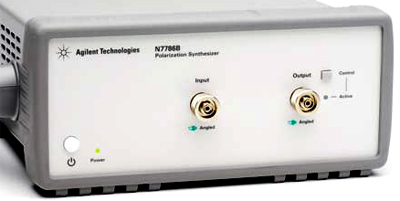
|
|
The Agilent N7786B Polarization Synthesizer contains a high-speed Lithium-Niobate based polarization controller and a polarization analyzer plus a microcontroller-based driving circuitry. As a polarization stabilizer, it provides a stable output state of polarization (SOP) even with fluctuations and drifts of the input SOP. The stabilized output signal is guided in a standard single-mode fiber (SMF). As an SOP switch, the N7786B cycles through a sequence of SOPs with a speed of more than 40 KHz, which corresponds to a cycle time of less than 25 microseconds. The sequence of SOPs can easily be defined by the user using Stokes coefficients. Specifications. Specification Wavelength range: 1270 nm to 1375 nm, 1460 nm to 1620 nm (Opt 400, O/C/L-Band), 1460 nm to 1620 nm (Opt 500, C/L-Band). Operating wavelength range: 1260 nm to 1640 nm. SOP switching time (non deterministic): < 10 µs. SOP cycling time: < 25 µs. Remaining SOP error after deterministic SOP setting (typical): < 3° at input SOP movement rate of 1.2 rad/s, < 6.5° at input SOP movement rate of 40 rad/s. SOP uncertainty (typical): 1.5°. DOP uncertainty: ± 2.0%. DOP uncertainty after user calibration (typical): ± 0.5%. Relative power uncertainty C/L-Band: ± 140 mdB (± 120 mdB typ.). Relative power uncertainty O-Band: ± 160 mdB (± 140 mdB typ.). Input power range -38 dBm to +19 dBm. Insertion loss: < 4.0 dB (< 3.5 dB, typ). PDL (typical): < 0.2 dB. Maximum safe input power: 20 dBm.
|